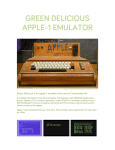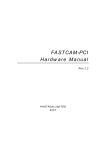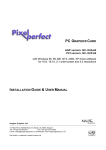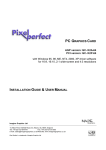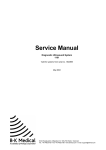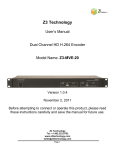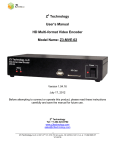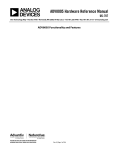Download OSSC scanconverter User Manual (fw. 0.26)
Transcript
OSSC scanconverter User Manual (fw. 0.26) 1. General info OSSC is a low-latency video digitizer and scanconverter designed mainly for connecting retro video game consoles and home computers into modern displays. It converts analog RGB/component video into digital format, and doubles (or triples) scanlines of a single frame if necessary to generate a valid mode for digital TVs or monitors. The following list summarizes the current features: • detection and digitization of various video modes from 240p to 1080p • linedouble-support for 240p, 480i, 288p, 576i • linetriple-support for 240p with 4 different sampling modes • very low latency (less than 2 input scanlines) • single-field "deinterlace" for 480i/576i: minimal latency overhead with decent image quality • quick recover from input video mode change (e.g. 240p<->480i) • all video processing done in RGB domain - no conversion to YCbCr • multiple inputs supporting various formats • RGBS via SCART connector • RGBHV/RGBS via VGA connector • YPbPr/RGsB via 3xRCA connector • full-range 24-bit RGB output through HDMI • emulated scanlines with configurable strength • configurable mask for overscan area • Selectable sampling configuration for 480p input: DTV-480p or VGA 640x480 • Selectable CSC configuration for YPbPr source: Rec. 601 or Rec. 709 2. Board setup and usage The current prototype board (PCB v1.0) requires the following for operation: • A power supply: DC 5V, min. 1A, 2.1mm/5.5mm barrel plug connector (center positive) • A remote control using NEC protocol (currently configured only for the bundled remote) • A microSD card for firmware upgrade (FAT16 formatted) – <=2GB cards most reliable, detection of SDHC/SDXC cards may vary • A HDMI or DVI display Except the power switch, the board is operated with a remote control. There is 2 keymaps for the remote: one for input selection and shortcuts, and one for using the system menu. The keymaps are illustrated below: Video mode info Sys reset Scanline strength - Scanlines on/of Dec./Inc. value Scanline strength + Horiz. mask -/+ Next/prev item Exit Menu Vert. mask -/+ Enter Menu Src select: 1 = RGBS (SCART) 2 = RGBHV (VGA) / RGBS (VGA) 3 = YPbPr (comp.) / RGsB (comp.) Figure 1: Main keymap Figure 2: Menu keymap After powering on the system, source is selected with keys 1-3. The format of a source (e.g. RGBHV or RGB on VGA) can be switched by pressing again the respective source key. Shortcut keys are provided for scanline and mask configuration, which can be also set along with other setting by using system menu. There are 4 LEDs on the board indicating the status of the scanconverter, as described below: • LED0: Line multiplication active • LED1: Remote control activity indicator • LED2: System cannot lock properly to input hsync • LED3: Variable input line length LED0 LED1 LED2 LED3 3. System menu options 1. TX mode Sets the output TX mode • HDMI: auxiliary HDMI packets are sent along with video data, such as Infoframes which indicate color settings (RGB, full-range) • DVI: Only video data is sent to the display. Required if target display does not support HDMI. 2. Scanlines Controls whether emulated scanlines are drawn on top of the picture • Off: No scanlines drawn • On: Scanlines drawn on every other (digitize & linedouble modes) or every third (linetriple) output line 3. Scanline str. • 12-100%: Strength of the emulated scanlines 4. Horizontal mask • 0-60 pixels: Controls the size of a mask (black border) generated around the picture in horizontal direction. Can be used to mask areas which would get hidden in the overscan region of CRT TVs. 5. Vertical mask • 0-60 pixels: Controls the size of a mask (black border) generated around the picture in vertical direction. Can be used to mask areas which would get hidden in the overscan region of CRT TVs. 6. 480p in sampler Controls the sampling mode when 525-line progressive signal (“480p”) is detected at input • Auto: “VGA 640x480”-mode is selected when the signal comes from RGBHV input. “DTV 480p”-mode is selected with all other inputs • DTV 480p: Input is sampled at 858 samples per line, typically associated with 720x480 mode (CEA-861 spec.) used by DTV/DVD equipment and newer game consoles. This option forces the sampling mode for all inputs, which may be required for optimal image quality when e.g. Dreamcast with a VGA module is connected to RGBHV input. • VGA 640x480: Input is sampled at 800 samples per line, typically associated with 640x480 mode used by PCs. This option forces the sampling mode for all inputs. 7. YPbPr in ColSpa Controls YPbPr->RGB colorspace conversion coefficients. • Rec. 601: Input is assumed to be in Rec. 601 format, which is generally true for SD video • Rec. 709: Input is assumed to be in Rec. 709 format, which is generally true for HD video 8. 240p linetriple Controls whether 240p is linetripled instead of standard linedouble. • Off: 240p is linedoubled, resulting to 480p output • On: --Experimental-- 240p is linetripled, which results to 720p output. However, the resulting mode does not have the same parameters (total lines, pixels per line) as the standard CEA 720p mode, so it is generally accepted only by monitors and not by many consumer TVs 9. Linetriple mode Controls the sampling and pixel clock multiplication mode for linetriple • Generic 16:9: Uses full horizontal sample rate without pixel multiplication, resulting to fully utilized 1280x720 output (16:9 aspect). • Generic 4:3: Uses 3/4 of full horizontal sample rate without pixel multiplication, resulting to 960x720 effective area of 1280x720 output (4:3 aspect). • 320x240 optim.: Uses a sampling rate which matches the DAC rate of 426 dots per line used by various classic consoles (e.g. PSX, Saturn) in 320x240 mode, resulting to pixelperfect digitization. Output is pixel-multiplied by 3 in horizontal direction, resulting to 960x720 effective area of 1280x720 output. Note: There is a bug that can sometimes cause picture jittering when this mode is initialized. A workaround is to toggle “240p linetriple” off and back on until initialization results to stable output. • 256x240 optim.: Uses a sampling rate which matches the DAC rate of 341 dots per line used by various classic consoles (e.g. NES, SNES, MD) in 256x240 mode, resulting to pixel-perfect digitization. Output is pixel-multiplied by 4 in horizontal direction, resulting to 1024x720 effective area of 1280x720 output. Note: There is a bug that can sometimes cause picture jittering when this mode is initialized. A workaround is to toggle “240p linetriple” off and back on until initialization results to stable output. 10. Firmware update Firmware can be updated via a microSD-card. Due to an issue in the reference SD device driver, currently only standard size cards (not SDHC/SDXC) are reliably recognized. The card must be formatted as FAT16, and the firmware file (ossc.rbf) must be placed on the root folder, after which firmware can be updated via the instructions on the character LCD.






